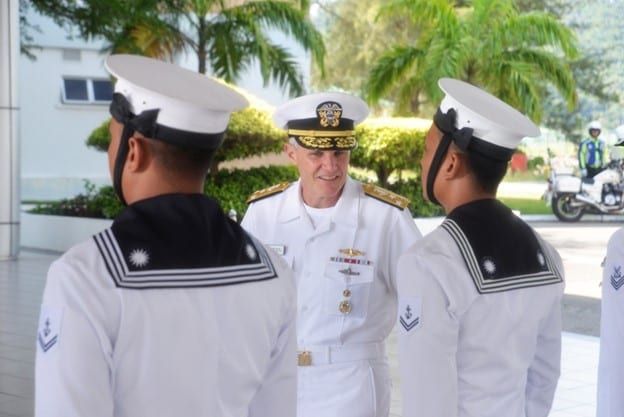
Navy Vice Adm. Phil Sawyer says the Chief of Naval Operation’s Navigation Plan 2020 and the Distributed Maritime Operations (DMO) concept are central for the Navy going forward and for the Navy and Marine Corps team’s ability to conduct enduring sea control and power projection missions.
Speaking at the NDIA Expeditionary Warfare Conference on Feb. 2, Sawyer, the deputy CNO for Operations, Plans and Strategy, said enduring means as a maritime nation, “the sea control and power projection mission hasn’t changed in 200 years, but the way we do it today has.”
The Navigation Plan 2020, released last month by CNO Adm. Mike Gilday, and the Tri-Service Maritime Strategy released last year, assert that the U.S. and Navy are “involved in a long-term competition that threatens our security and our way of life. Russia and China are both undermining the free and open conditions that has enabled the world to largely prosper since the end of World War II.”
Both countries are attempting to unfairly control sea-based resources, intimidate their neighbors, and both are turning incremental gains into long-term advantages, with Crimea and the South China Sea as examples.
Although we must be clear-eyed about both Russia’s and China’s actions and intentions, Sawyer said China is the long-term strategic threat to the U.S. “That is not to discount Russia, but it looks like China is our pacing threat.”
“The nation needs a larger hybrid fleet — consisting of manned and unmanned platforms,” Sawyer said “But, it’s not just the number, but it’s about the composition of the fleet.”
Sawyer said unmanned platforms will play a very important role, from ISR above, on and below the sea, to platforms that are large weapons batteries to aerial refuelers.
He said it’s easy to fixate on numbers, but the mix is also very important. “Getting the right mix of platforms is just as important as the total number.”
The Navigation Plan calls for a lethal, better connected fleet — a fleet that is able to deliver synchronized lethal and nonlethal effects across all domains. That includes distributed weapons of increasing range and lethality Hypersonic and directed energy weapons are key R&D efforts for the Navy, he said.
Tying the Navigation Plan to theme of the NDIA conference, “Distributed Maritime & Expeditionary Operations in a Peer Contested Environment,” Sawyer said, “DMO is principally a warfighting concept. It’s our operational approach to winning the high-end fight at sea.”
According to Sawyer, DMO is geographically distributed naval forces integrated to synchronize operations across all domains. “DMO is a combination of distributed forces, integration of effects, and maneuver. DMO will enhance battle space awareness and influence; it will generate opportunities for naval forces to achieve surprise, to neutralize threats and to overwhelm the adversary; and it will impose operational dilemmas on the adversary.”
A key capability to achieving DMO is the Naval Operational Architecture, which Sawyer said will enable decision superiority at speed in a high-end fight. “It’s the connective tissue between sensors, platforms and weapons, and its central to our DMO operating concept,” Sawyer said. It’s more than “every sensor connected to every shooter.”
It includes the infrastructure (computing power and data storage); the network (data links, antennas, routers, and protocols); a data architecture and a data strategy; and finally, the tool (tactical decision aids to help analyze and display data with understandable and actionable information to the operators).
The ability to communicate and share information is critical in a contested environment, he said.
“In peacetime, or against lesser adversaries, we know how to C2 distributed forces. We do it all the time. We know how to synchronize effects in time. We know how to dynamically maneuver our forces. What we working on is how to do this — assuming every domain is contested, or denied — and with speed, such that we decision superiority.”
Another DMO imperative is logistics, and an enterprise to operate and sustain us in a contested space. That will require new platforms, manned and unmanned, to sustain small, dispersed units far to the front.
DMO is not a Navy or Marine Corps problem. “DMO is a naval concept. Navy and Marine Corps integration is pivotal to us winning the high-end fight, particularly in the Pacific,” Sawyer said. “In the future, the Marine will be able to project power in order to support sea control or sea denial efforts.”
Sawyer said the Navigation Plan fully supports DMO, and fueling those capabilities necessary to fully realize the DMO concept. “New capabilities are important. But while the fleet waits for the introduction of these capabilities, we are moving out and exercising with what we have.”
- A Day to Remember - September 11, 2023
- Indo-Pacific Maritime Security Exchange will examine emerging capabilities and capacity - July 12, 2023
- Cold Waters Spark Warm Relationship - April 20, 2023






